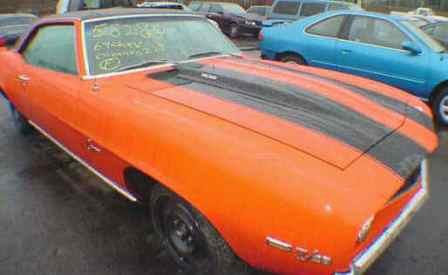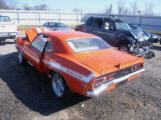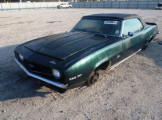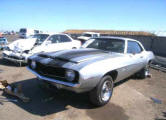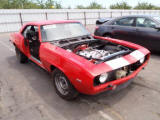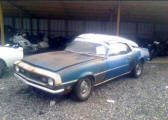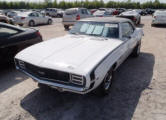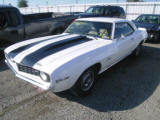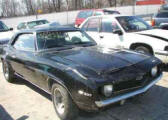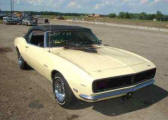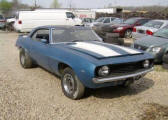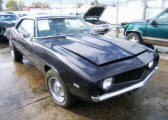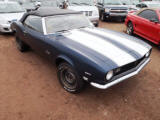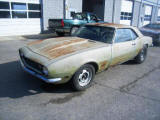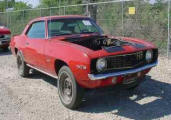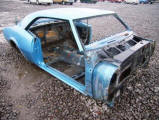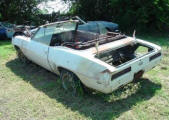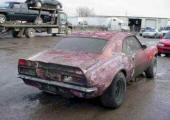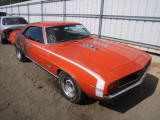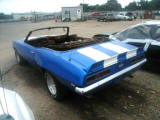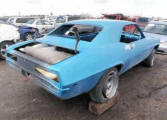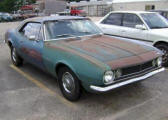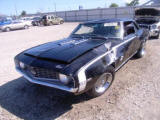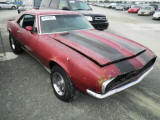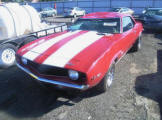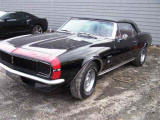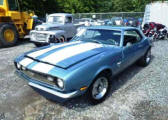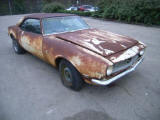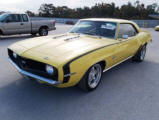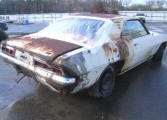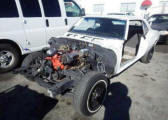CAMARO PROJECT CARS FOR SALE - 1967 1968 1969
1969 CAMARO Z28 - Theft Recovery - $4,900 - VHJ-257 We offer the largest inventory of Camaro project cars and repairable salvage cars for sale. Choose from more than 12,0000 salvage cars, motorcycles, trucks, jet skis, boats, atvs, rvs, semi trucks, trailers, tractors, industrial equipment and classic project cars for sale at deeply discounted prices. * Cars
can be inspected and purchased in-person or bought online and delivered
to any location. HERE ARE SOME EXAMPLES FROM OUR CAMARO INVENTORY - CLICK PHOTOS TO ENLARGE
We offer a large inventory of over 12,000 repairable
salvage motorcycles, boats, trucks, cars, rvs, atvs.
We are the leading salvage car specialist and these are only a few examples of the cars for sale. Go to our website to choose from more than 12,000 repairable salvage cars, motorcycles, trucks, boats, rvs, atvs, semi trucks, trailers, forklifts, tractors, jet skis, tractors, snowmobiles, industrial equipment and classic project cars for sale at deeply discounted prices. Vehicles can be purchased online and delivered to any location worldwide or buy them in-person and haul them away yourself. CLICK HERE to view our entire inventory of repairable salvage and project cars for sale. * We
back our business with a 100% Money-Back Guarantee.
Inventory changes daily and listings are subject to prior sale. |
THE CAMARO HISTORY 1967 - 1968 - 1969
1967 CAMARO
After two years of watching the Ford Mustang enjoy tremendous success, General
Motors finally launched its entry into the pony car segment, the Chevrolet
Camaro. Although available with a mediocre six cylinder for volume sales, the
Camaro could be equipped with several V8s and a myriad of performance options.
Then, of course, was the famous Regular Production Code, Z/28, that would change
the industry's view of pony cars.
Inspired by the success of the Ford Mustang,
Chevrolet launched its own pony car, the Camaro. Chevrolet stated that the
"Camaro" was named after the French word for "comrade," although some linguists
argued that it was actually Spanish for a type of shrimp. Not exactly an awe
aspiring name for a new pony car. Luckily, the Camaro had the muscle to back up
its case. The Camaro was based on the upcoming 1968 Chevy Nova platform, and
featured a unibody structure from the windshield and firewall back, with a
separate steel rail subframe for everything up front. The Camaro was available
from the start in hardtop coupe and convertible body styles, and could be order
with nearly 80 factory options and 40 dealer accessories, including three main
option packages and a choice of four different engines. The RS package included
numerous cosmetic changes including a blacked out grill with hidden headlights,
revised parking and tail lights, upgraded interior trim, and RS badging. Of
greater interest to enthusiasts was the SS package which included as standard
equipment a modified 350 cid V8 (the first 350 engine Chevy ever offered) with
an available 396 cid big block producing 325bhp (L35) and later a 375bhp
version, along with simulated air-intakes on the hood, special bumble bee
striping, and a blacked out grill. It was possible to order both the RS and SS
packages, and get a RS/SS Camaro, in which case the RS badging took precedence.
Camaro popularity soared when a RS/SS Convertible with the 396 paced the 1967
Indianapolis 500 race.
In December 1966, Chevrolet then quietly released one
of the most famous options codes of all time, option Z-28. Unpublicized and
unknown by most of the buying public (and most Chevrolet sales people for that
matter) and not mentioned in any sales literature, the only way someone could
order the Z-28 package was to order a base Camaro with the Z-28 option,
mandatory front disc brakes with power assist, and the Muncie 4-speed
transmission. You could not order the SS package, automatic transmission, air
conditioning, or the convertible. What you got was a unique 302 cid small block
(Non-California emission cars were labeled MO while California emission engines
were labeled MP) that was created by taking the 327 block and installing the
short-stroke 283 crank. Specifically designed to compete in the Club of America
Trans Am racing series which placed a 305 cid limit on its entries, the Z-28 was
available to the public solely to qualify the car for racing. Advertised
horsepower was listed at just 290bhp, which was not very impressive until one
hooked it up to a dyno and got actual readings of 360-400 bhp. The Z-28 also
came with a competition suspension, broad racing stripes on the hood and trunk
lid and could be combined with the RS option package. There was no Z-28 badging
at all, lest it attract to much attention. The Z-28 proved to be difficult to
launch on the street because its high revving engine was lethargic under 4000rpm
and worked best when it was shifted at 7500rpm (!). Once it got going, the Z28
was tough to beat and boosted a 140mph top speed and numerous racing victories.
Only 602 Z-28s were sold in 1967, making it a truly desirable collectable.
Production:
RS: 64,842
SS: 34,411
Z-28: 609
Engines:
230 I6 140bhp.
250 I6 155bhp @ 4200rpm, 235lb-ft @ 1600rpm.
(Z-28) 302 V8 290bhp @ 5800rpm, 290lb-ft @ 4200rpm.
327 V8 210bhp.
327 V8 275bhp.
350 V8 255bhp.
(SS350) 350 V8 295bhp @ 4800rpm, 380lb-ft @ 3200rpm.
(SS396) 396 V8 325bhp @ 4800rpm, 410lb-ft @ 3200rpm.
(SS396) 396 V8 375bhp @ 5600rpm, 415lb-ft @ 3600rpm.
The first Camaro model was the 1967, introduced on
September 26, 1966. At the time of introduction, several important options were
not available. These included the RPO-Z28 Special Performance Package, and the
396-cid displacement engine for Camaro SS models. The 1967 model was the only
first generation Camaro to have both rear shocks mounted forward of the rear
axle. Later years changed to a staggered arrangement to counter wheel hop. The
1967 was the only Camaro to feature a right-side traction bar, also to counter
wheel hop. The traction bar was standard equipment for all Z28 models, and was
installed on other high performance models. The 1967 Camaros did not have side
marker lights. The 1967 Camaro was the only Camaro model to have its VIN tag
mounted to the door hinge pillar. The VIN tags of later models moved to
positions visible through the windshield. The bumblebee nose stripe was part of
the SS package at the start of 1967 production, but became a separate option
(RPO-D91) in March 1968. Chevrolet built three special Camaro pace cars for the
1967 Indianapolis 500 auto race. It also built 78 lookalikes for complimentary
use by race officials and dignitaries during the month preceding the race. After
the race, these lookalikes were sold to the public as used cars. All were white
SS/RS convertibles with Bright Blue custom interiors. Other options varied. All
had "Chevrolet Camaro Official Pace Car 51st Annual Indianapolis 500 Mile Race -
May 30, 1967" decals on their doors. (Chevrolet also built anywhere from 100-560
Pace Car Replicas for a special "Pacesetter" campaign which ran through June,
plus 21 cars exported to Canada. The actual number of these cars is unknown,
this number is my guess - Greg McGann) When first introduced in September 1966,
the 1967 Camaro SS came only with a 350-cid engine, an engine displacement
exclusive to the Camaro within the Chevrolet line that year. In November 1966,
the 396-cid engine was added to the SS option list. Though similar to 1968, the
1967 instrument panel was unique to the year. Its padding did not fold over the
corners as did the following year. And, with the exception of air conditioned
models, the 1967 instrument panel did not have the side air (Astro Ventilation)
vents. The ignition for the 1967 model (and 1968) was located on the dash. The
first Z28 models were built starting on December 29, 1966, and low volume
delivery began in January 1967. The Z28 was initially developed as a contender
for the SCCA (Sports Car Club of America) Trans Am sedan racing series. The
series had a displacement limit of 305 cubic inches which the Z28 met by
combining a 327-cid Chevrolet block with a 283-cid Chevrolet crankshaft for a 4"
x 3" stroke that yielded 302.3 cubic inches. The "Z" in Z28 was at first nothing
more than another option code, along with others like Z23 for the Special
Interior Group, or Z87 for the Custom Interior. But the Z28 had a special ring
to it and became the model's official name. However, the Z28's built in 1967
carried no external identification other than wide racing stripes. Convertibles
could not be ordered with the ZZ8 option The 1967 was the only Camaro model to
feature side vent windows. The headlight door covers of the 1967 Camaro were
electrically operated. Later model years were vacuum operated. All 1967 Camaros
had single leaf rear springs. The center console design used in 1967 was unique
to the year. Additionally, the design of the optional instrument grouping which
mounted to the console was unique to 1967. The secondary instrument cluster
consisted of fuel gauge, temperature gauge, oil gauge, ammeter, and clock. The
first 1967 Camaro built at the Norwood, Ohio, plant had a VIN ending in N100001;
the first built at the Van Nuys, California, plant had a VIN ending in L100001.
Performance:
(Z-28) 302/290bhp: 0-60 in 6.9 sec, 1/4 mile in 14.85
sec @ 101mph.
(SS350) 350/295: 1/4 mile in 15.4 seconds @ 90 mph.
(SS396) 396/325bhp: 0-60 in 6.0 sec, 1/4 mile in 14.5
sec @ 99mph.
1968 CAMARO
The 1968 received minor changes for its second year. The grill took on a more
horizontal look while the vent windows were dropped and "Astro Ventilation"
(i.e. flow-through ventilation) was added. Side marker lights were added while
the SS396 received revised chromed hood inserts (the SS350s stayed with the 1967
styling). Underneath, the 1967 Camaros pesky axle tramp was cured by the
addition of multi-leaf rear springs to replace the single-leaf units and rear
shock absorbers were now staggered. A new 350bhp 396cid option for the SS was
added, while the Z-28 option (now just labeled MO) actually received some
publicity and sold 7,199 units. The Z-28s were now easier to spot as they
sported Z-28 or 302 badges.
The 1968 Camaro model featured a restyled center
console, and a restyled secondary gauge package with a "saw tooth" design. The
saw tooth design didn't contain a clock, so when the optional instrument package
was ordered, the clock was combined with the tachometer in the right side
instrument pod creating 1968's Tick-Tock-Tach. The 1968 Camaro was the first to
feature Astro Ventilation. It did not have side vent windows. Side marker lamps
were used for the first time in Camaros in 1968. The dash location for the
ignition was last used in the 1968 Camaro model . The headlight cover doors in
1968 Camaros were vacuum operated rather than electric as before. Cloth
upholstery was used for the first time in Camaros in 1968 with the introduction
of the famous hounds tooth cloth pattern in black and white check. The Torque
Drive transmission, a Powerglide automatic that was shifted manually, became
available in 1968 Camaros. The bumblebee nose stripe continued in 1968, but was
joined by two other striping styles. One wrapped across the top of the nose,
down the leading edge of the front fender to a point about four inches above the
bumper, then horizontally back to almost the end of the door. The other nose
stripe was multicolored and came as part of a special Customized Camaro sales
promotion. The sales promotion required selection of Rallye Green, Brite Green,
Corvette Bronze, or LeMans Blue exteriors. To neutralize the wheel hop problems
associated with the 1967 models, the 1968 Camaro received staggered rear shock
absorbers (the passenger side shock passed behind the axle and the driver-side
ahead of the axle). Also, multi-leaf springs were added to V-8 models except for
those powered by 210-hp and 275-hp versions of the 327-cid engine. Four-wheel
disc brakes were not factory options for 1968. They were installed on 1968
Camaros, but only by dealers, or customers who purchased them
across-the-counter. The Z28 option continued in 1968, and Z28 models had either
302 or Z28 emblems on their front fenders. The cross ram intake manifold with
dual four-barrel Holley carburetors became available across-the-counter. The
grille of non-Rally Sport 1968 Camaros was redesigned to have a more distinct
center split. Non-Rally Sports had backup lights incorporated within the
standard taillight bezels. The backup lights for Rally Sports were separate
units below the bumper. The tail lamps of all 1968 Camaros had center splits to
create a four-lamp (two per side) appearance. A passenger-side grab handle
(mounted above the glove box) came as part of the Custom Interior or Special
Interior groups in 1968 Camaros. Nineteen-sixty eight Z28 Camaros are often seen
with rear spoilers, but the spoiler (actually called an auxiliary panel and
valence) was a separate option as RPO-D80. They were fiberglass. Camaro SS
models had unique hoods in 1968, and the hoods were different for SS-396 and
SS-350 models. The SS-350 models had the same style as all 1967 SS models which
featured two thin-ribbed, decorative inserts. The SS-396 models featured two
inserts which each had four simulated carburetion stacks.
Production:
RS: 40,977
SS: 27,884
Z-28: 7,199
Engines:
230 I6 140bhp.
250 I6 155bhp @ 4200rpm, 235lb-ft @ 1600rpm.
327 V8 210bhp.
327 V8 275bhp.
350 V8 255bhp.
(SS350) 350 V8 295bhp @ 4800rpm, 380lb-ft @ 3200rpm.
(SS396) 396 V8 325bhp @ 4800rpm, 410lb-ft @ 3200rpm.
(SS396) 396 V8 350bhp @ 5200rpm, 415lb-ft @ 3200rpm.
(SS396) 396 V8 375bhp @ 5600rpm, 415lb-ft @ 3600rpm.
Performance:
(SS396) 396/325bhp: 0-60 in 6.6 sec, 1/4 mile in 15.0
sec @ 94mph
1969 CAMARO
1969 saw several noteworthy changes to the Camaro. The grill became deeper set,
the tail lamps were longer and thinner and broken into three segments. A heavy
"eye-brow" crease was added on the both sides of the car extending from the
front wheel well to the rear wheel well. A matching crease went from the rear
wheel well to the rear quarter panel. The Camaro also received new fenders, door
skins, rear quarter-panels, grille and taillights which gave it a wider, lower
appearance. Inside, the Camaro received a redesigned dash and more comfortable
seats. Endura rubber bumpers were available on the Camaro as well as two ram air
induction systems for the SS. The first was a new special hood with a rear
facing inlet and cold-air duct underneath the hood. The second was a dealer
installed cowl plenum kit that came with a special air cleaner and adapter. No
special hood was needed. 1969 saw an explosion in engine choices. On the
low-performance side, a new 307 V8 (a 327 crank in a 283 block) rated at 200bhp
was added and a new 350 V8 rated at 255 bhp replaced the more powerful 327
engine. The Z28 continued with its seriously under-rated 302 (now called DZ)
engine. The RS package was still popular, and included a special grill with
concealed headlights (of a ribbed design) and washers, chrome wheel well
moldings, drip rails, pinstripes, and RS badging. The SS standard 350 received a
slight power boost to 300 bhp while the 396 engines continued in 325/350/375 bhp
versions. Once again, a white RS/SS convertible with the 396 engine paced the
Indianapolis 500 race, and Chevy offered replica versions as white convertibles
with orange stripes and orange hounds tooth upholstery (though most replicas
were powered by 350 engines. Because of their collectability, there are many
"fake" 1969 Pace Car replicas out in the collector market so be careful if you
are planning on buying one.
But real performance is more than special upholstery
and the big news for 1969 was the availability of special 427 cid V8 equipped
Camaros. The first were special dealer-installed units, most notably the Yenko
Camaro 427. Yenko Sports Cars, based in Pennsylvania, along with other Chevy
dealers such as Nickey in Chicago, Dana in California, and Baldwin-Motion in New
York, would install the L72 427 cid block, rated at 425bhp by Chevrolet, ordered
under the Central Office Production Order System (COPO) code 9562 into a buyer's
Camaro. The Yenko Camaro 427 is a typical example: it came from the factory with
no ornamentation, badging, and the 427 engine in a crate. Yenko installed the
427 block, changed the rating to a more realistic 450bhp, and added 15-inch
rally wheels, bigger front roll bar, and sYc (Yenko Sports Car) badging. A full
complement of racing add-on's were available and sub 13 second quarter miles
were possible with a few more dollars.
The 1969 Camaro was the highest volume first
generation Camaro, selling 243,085 units in a long model run that extended from
September 26, 1968, through the end of November, 1969. The 1970 model Camaro
wasn't introduced until February 26, 1970. This production total wasn't exceeded
until 1978. Although part of the first generation of Camaros, the 1969 model
received an extensive exterior and interior facelift. New exterior sheet metal
included header, valance, fenders, doors, rear quarters, and rear end panel.
Wheel wells were flattened for a more aggressive look. The standard grille was
redone with sharper angles. The grille of the Rally Sport 1969 models featured
vacuum operated covers over the headlights, but the covers had see through slits
to permit partial lighting if the doors stuck. The 1969 Camaro was the only
model year to have headlight washers. The system was operated by vacuum much
like windshield washers. The headlight washers were included with all Rally
Sports and could be purchased separately as RPO-CE1. Turbo Hydra-Matic automatic
transmissions were available in any 1969 Camaro except Z28's. Availability was
more restricted in previous years. Variable-ratio steering appeared in Camaros
for the first time in 1969. This meant that as the steering wheel was turned,
the wheels turned progressively more as they approached lock. This permitted
faster steer but prevented excessively quick response in straight-line driving.
The console and secondary saw tooth instrument cluster designs remained as in
1968, but the 1969 Camaro did get a redesigned main instrument panel. It
featured two main pods as before, but 1969's were squared off instead of round.
A smaller pod was placed between the two bigger ones. In the standard
arrangement, the left pod housed the speedometer, the right pod the fuel gauge,
and the center pod the optional clock. With the Special Instrumentation option,
the secondary gauges (fuel, battery, temperature, oil) were mounted on the
console, the tachometer rook over the big right side pod, and the clock again
went into the center pod. If a tachometer was purchased separately in 1969
Camaros (the first time this could be done), the fuel gauge was relocated to the
small center dash pod normally reserved for the clock. The 427-cid engine never
appeared on 1969 dealer order sheets, but some were specially ordered by
dealers. These were legitimate factory built vehicles. These 427-cid Camaros are
known as COPO cars, the letters signifying Central Office Production Order. COPO
9560 Camaros included an aluminum block "ZL1" 427-cid engine. Sixty-nine of
these Camaros were built, fifty for Chevrolet dealer-racer Fred Gibb and
nineteen for other dealers. Although Chevrolet had toyed with the idea of a
special graphics package for ZL1 Camaros (and actually built two for its own
use), the ZL1 Camaros released to the public carried no special exterior
identification. The option cost was $4,160, more than the base Camaro itself. A
second category of COPO 1969 Camaro was COPO 9561. These had iron-block 427-cid
engines. Chevrolet dealer-racer Don Yenko received 201(or 199, depending on the
source) of these Camaros and sold some of them through his dealership with
special Yenko graphics. Most of the Yenko Super Camaros were sold through
Yenko's distributorship, SPAN, Inc. Additional iron-block 427-cid Camaros were
factory-built under COPO 9561, but the quantity isnít presently known.
Additionally, dealer and owner installations of 427-cid motors into 1969 Camaros
were common. Four-wheel disc brakes adapted from the Corvette became a
legitimate factory option in 1969. It is a misconception that these were factory
options only with Z28 and SS models. You could purchase RPO JL8 for any Camaro,
but it cost more if it wasn't a Z/28 or SS - $623.50 instead of $500.30. The
design of these brakes was completely different from the front disc rear drum
option for 1969. The disc/drum combination used a new single piston, floating
caliper design. The Corvette style was non-floating with four pistons per wheel.
The 1969 Camaro was the first to offer two-tone paint. The Camaro was the pace
car for the Indianapolis 500 auto race in 1969. Chevrolet sold 3,675 replicas of
the pace car under Regular Production Option Z11. These were SS Rally Sport
convertibles with code 911 Dover White exteriors, orange hounds tooth cloth
seats, custom interiors, orange striping, white body sills and rear panels,
Rally Wheels, bright exhaust tips, and cowl induction hoods. Other options
weren't mandatory, but to match the actual pace car, the following RPO's had to
be ordered: A01, A39, A85, C06, D55, D80, G80, M40, N34, N40, U17, and U63.
There were also a limited number of Pace Car hardtops produced under RPO Z10.
All 1969 Camaros with four-speed transmissions came with Hurst shift linkages .
Cowl induction hoods with rear facing cold air inlets were installed on all
427-cid COPO 1969 Camaros, on the pace car replicas, and could be
factory-ordered for any SS or Z28. A fiberglass version of the cowl induction
hood was also sold over-the-counter for use with the dual four-barrel carburetor
cross ram setup, or (with an adapter) with single four-barrel engines.
Factory-applied stripes on 1969 Camaros with rear spoilers did not cover the
small portion of trunk exposed between the spoiler and the taillight panel.
Dealers and owners often painted the trunk lip. Production of the 1969 Camaros
continued into the beginning of 1970 as the all new 1970 Camaros were not
released until mid 1970. To add to the confusion, some late 1969 cars were
titled as 1970 models.
Production:
RS: 37,773
SS: 33,980
Z-28: 19,014
Engines:
250 I6 155bhp @ 4200rpm, 235lb-ft @ 1600rpm.
Z28: 302 V8 290bhp @ 5800rpm, 290lb-ft @ 4200rpm.
307 V8 200bhp @ 4600rpm, 300lb-ft @ 2400rpm.
327 V8 210bhp.
327 V8 275bhp.
350 LM1 V8 255bhp.
(SS350) 350 V8 300bhp @ 4800rpm, 380lb-ft @ 3200rpm.
(SS396) 396 V8 325bhp @ 4800rpm, 410lb-ft @ 3200rpm.
(SS396) 396 V8 350bhp @ 5200rpm, 415lb-ft @ 3200rpm.
(SS396) 396 V8 375bhp @ 5600rpm, 415lb-ft @ 3600rpm.
(COPO 9561) 427 V8 425bhp @ 5600rpm, 460lb-ft @
4000rpm.
(COPO 9560) 427 V8 430bhp @ 5200rpm, 450lb-ft @
4400rpm.
Performance:
(Z-28) 302/290bhp: 0-60 in 7.4 sec, 1/4 mile in 15.12
sec @ 94.8mph.
(SS396) 396/375bhp: 0-60 in 6.8 sec, 1/4 mile in 14.7
sec @ 98.7mph.
(COPO 9561) 427/425bhp: 0-60 in 5.4 sec, 1/4 mile in
13.5 sec @ 102mph.
(COPO 9560) 427/430bhp: 0-60 in 5.3 sec, 1/4 mile in
13 seconds.
.
CLICK HERE to view
our entire large inventory of repairable salvage and project cars for sale.
